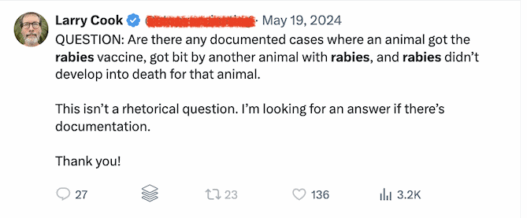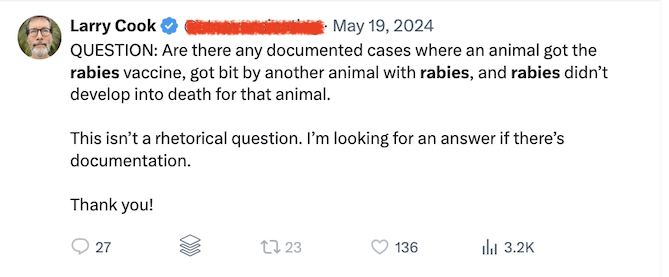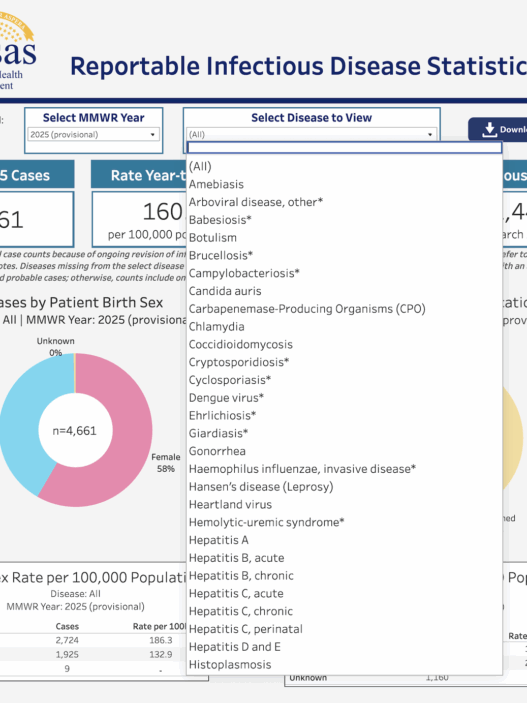Seems simple enough. You get exposed to rabies and then you get rabies post-exposure prophylaxis, including a series of rabies vaccines, right?

It’s not so simple for anti-vaccine influencers…
Questions and Answers about Rabies and Rabies Vaccines
Some of them are so extreme that they even question the need for rabies vaccines!

They try to scare people away from vaccinating and protecting their pets (dogs, cats, and ferrets).
Let’s answer some questions so that you hopefully won’t be one of them.
- Why do indoor pets require a rabies vaccine?
That seems like a fair question.

If your dog or cat is always inside, how will they ever be exposed to rabies, right?
The thing is, is your indoor pet really always inside?
Indoor dogs typically go outside to use the bathroom and go for walks, and it is not rare for indoor dogs and cats to escape and run away from time to time.
“On Monday, August 5, 2024, two South River residents found a live bat in their home. The animal was picked up by the Animal Control Officer and was then taken to the New Jersey Department of Health Laboratory for testing. It was reported on Wednesday, August 7, 2024, that the animal tested positive for rabies. There were three exposures to the bat, the two residents and their dog. It was recommended that the residents contact a physician regarding any rabies post exposure treatment. Also, it was recommended that they contact a veterinarian regarding their dog. The dog is currently vaccinated for rabies.”
Bat Tests Positive for Rabies in South River
There is even the chance that a bat with rabies could get in your home and become a plaything for your indoor pet.
“Three bats that were captured while flying around in some South Sound homes were tested for rabies, according to a release from Thurston County Public Health and Social Services.
Each bat was collected from a home where it was flying around in the bedrooms where people were sleeping.
Officials said one bat was caught by a cat, another by a dog and the third by the residents at one home.
The bats were tested by the Washington State Public Health Lab, which confirmed one bat tested positive for rabies. That bat was caught by the cat, officials said.”
1 of 3 bats found flying in Thurston County homes tests positive for rabies
And these types of exposures are not as rare as you might think!

So while being indoors does lower their risk, it is not a guarantee that they won’t be exposed to rabies.
“A rabid bat was found on Phillips Road in the Town of Newfane earlier this week.
The bat was captured in a home on Monday, prompting the Niagara County Department of Health Department to launch an investigation. The bat was taken to Health Wadsworth Laboratory for testing.
The health department on Thursday afternoon confirmed that it had tested positive for rabies. A cat from the home is in quarantine while officials await its rabies vaccination status. Post-exposure shots are being considered for the people in the home.”
Rabid bat confirmed in the Town of Newfane
And know that it is a death sentence if your unvaccinated pet is exposed to rabies.
“A bat found inside a home in the City of Watertown tested positive for rabies, according to a press release from Jefferson County Public Health… There were no known human exposures in the recent rabies detection, however, a pet cat was exposed to the rabies virus, Public Health confirmed the press release. The cat was not vaccinated against rabies and had to be subsequently euthanized.”
Rabid bat found in Watertown home, cat exposed
A death that can be easily be prevented by keeping your pet up to date on their vaccinations.
2. Do you really need a rabies vaccine if you get exposed to rabies?

Yes, you really need post-exposure rabies prophylaxis, including a rabies vaccine series, if you are exposed to rabies. Your pet will get a booster shot and quarantine.
High dose vitamin C ain’t gonna cut it!
If you don’t, and you were bitten by:
- a rabid bat, there is nearly 100% chance that you will get rabies and die
- a rabid dog, there is a 15-60% chance you will get rabies and die, with a higher chance with a deep bite to the face or head
- a rabid raccoon, skunk, fox, or cat — a moderate to high chance you will get rabies and die
How do we know?
“A third study in Thailand in 1987 documented no deaths among 723 persons bitten by dogs (661 of these persons were bitten by confirmed rabid dogs) who received one of three rabies vaccines: Semple vaccine (n = 427), HDCV (n = 257), or duck embryo vaccine (n = 39). However, 45% (nine of 20) of unvaccinated persons who were bitten by confirmed rabid dogs died from rabies. All of the persons who died were severely bitten on the face, neck, or arms. All unvaccinated persons who survived after having been bitten by confirmed rabid dogs were bitten either on the legs or feet.”
Human Rabies Prevention — United States, 2008
Believe it or not, there are vaccinated vs. unvaccinated studies with folks bitten by rabid animals! Folks who refused treatment…
3. Do rabies vaccines work?
Of course, in addition to trying to make you think rabies vaccines are dangerous, anti-vaccine influencers try to make you think they aren’t necessary.

That vaccines don’t work.

Of course, we know that they do work.
And yes, there have been studies of vaccinated pets who have been exposed to rabies.
“A total of 264 rabid dogs and 840 rabid cats were identified during the study period. Thirteen (4.9%) rabid dogs and 22 (2.6%) rabid cats had a history of rabies vaccination. Of these, 2 dogs and 3 cats were classified as currently vaccinated. Overall, 6 animals (1 dog and 5 cats) had a history of receiving 2 doses of rabies vaccine in their lifetime, including 2 cats that were classified as currently vaccinated.”
Rabies in vaccinated dogs and cats in the United States, 1997-2001
Almost all of these vaccinated pets are protected against developing rabies.
“Vaccine failures were documented in 3 (1%) rabid animals (2 cats and 1 dog). All animals had received only a single dose of vaccine in their lifetime and were vaccinated when they were between 3 and 6 months old.”
Epidemiologic factors, clinical findings, and vaccination status of rabies in cats and dogs in the United States in 1988. National Study Group on Rabies
And those who are unvaccinated get rabies and die.
4. Can unvaccinated pets get post-exposure prophylaxis if they are exposed to rabies?
Unfortunately, they can not.
“There are currently no USDA-licensed biologics for postexposure prophylaxis of previously unvaccinated domestic animals, and there is evidence that the use of vaccine alone will not reliably prevent the disease in these animals.”
Compendium of Animal Rabies Prevention and Control, 2016
Unvaccinated pets who are exposed to rabies are euthanized.
4. Is the rabies vaccine safe?
We have been using rabies vaccines for over one hundred years!
In 1885, nine-year-old Joseph Meister was the first person to be successfully vaccinated against rabies after he was bitten by a rabid dog.
Not that we are still using a hundred-year-old vaccine…
We currently use the newer Imovax and RabAvert rabies vaccines that were approved by the FDA in 1980 and 1997.
And there are also several new and improved rabies vaccines that are used for our pets.
All have been shown to be very safe, with few serious risks.
“In summary, findings within this report do not suggest a high frequency or unexpected pattern of adverse events associated with the use of rabies vaccines in veterinary medicine. Nearly 120 million doses of rabies vaccine were distributed within the United States during the 3-year period.”
Postmarketing surveillance of rabies vaccines for dogs to evaluate safety and efficacy
Which leaves one last question — why would you leave your pets unvaccinated and at risk to get rabies?
More on Rabies
Last Updated on April 25, 2025






